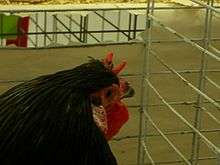
Thirty-nine varieties of chicken (and one Guinea Fowl).
There are hundreds of chicken breeds in existence.[1] Domesticated for thousands of years, distinguishable breeds of chicken have been present since the combined factors of geographical isolation and selection for desired characteristics created regional types with distinct physical and behavioral traits passed on to their offspring.
The physical traits used to distinguish chicken breeds are size, plumage color, comb type, skin color, number of toes, amount of feathering, egg color, and place of origin.[1] They are also roughly divided by primary use, whether for eggs, meat, or ornamental purposes, and with some considered to be dual-purpose.[1]
In the 21st century, chickens are frequently bred according to predetermined breed standards set down by governing organizations. The first of such standards was the British Poultry Standard, which is still in publication today.[2][3] Other standards include the Standard of Perfection, the Australian Poultry Standard, and the standard of the American Bantam Association, which deals exclusively with bantam fowl.[3] Only some of the known breeds are included in these publications, and only those breeds are eligible to be shown competitively. There are additionally a few hybrid strains which are common in the poultry world, especially in large poultry farms. These types are first generation crosses of true breeds. Hybrids do not reliably pass on their features to their offspring, but are highly valued for their producing abilities.[1]
By place of origin
- Commune hen[4]
- Black Tropoja Lekbibaj[4]
- Tirana[4]
|
|
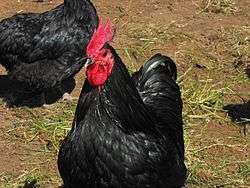
The Australorp, an Australian breed
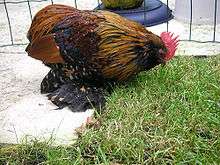
The d'Everberg, a Belgian ornamental bantam
|
|
- Fauve de Hesbaye or Gele van Haspengouw[6]
- Fauve de Mehaigne or Gele van Mehaigne[7] (bantam)
- Herve or Hervehoen[6][7] (large and bantam)
- Huttegem[4]
- Malines or Mechels hoen[6][7] (large and bantam)
- Mechelse kalkoenkop[4]
- Naine belge or Belgische kriel[7] (bantam)
- Naine de Waes or Waasse kriel[7] (bantam)
- Naine du Tournaisis or Doornikse kriel[7] (bantam)
- Pondeuse de Zingem or Zingems leghoen[6]
- Poule d'Aarschot or Aarschots hoen[6]
- Poule de la vallée de la Zwalm or Hoen van de Zwalmvallei[6]
- Poule de Zottegem or Zottegems hoen[6]
- Zingems vleeshoen[4]
|

Black Shumen cock
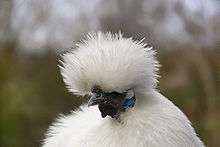
A Silkie hen
PeKin Oil Chicken, namely, China Court Yellow Chicken,is a breed own about more than 300 years history in Bei Jing, the Capital of China.
- Hrvatica (Croatian Hen, Kokoš Hrvatica)[8][9]
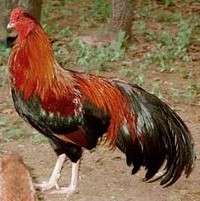
Cubalaya cock
.jpg)
The oldest German breed, the
Bergische Kräher (Historical illustration by Jean Bungartz, 1885)
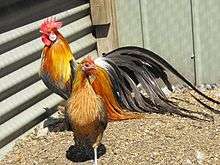
The longtailed
Phoenix, a German breed derived from the Japanese Onagadori
Large breeds
- Annaberger Haubenstrupphühner[17][18]
- Augsburger[17][18]
- Bergische Kräher,[17][18]
- Bergische Schlotterkämme[17][18]
- Bielefelder Kennhuhn[17][18]
- Deutsches Lachshuhn,[17] see Faverolles[18]
- Deutsche Langschan,[17] see German Langshan[18]
- Deutsches Reichshuhn[17][18]
- Deutsche Sperber[17][18]
- Dresdner[17][18]
- Hamburger,[17] see Hamburg[18]
- Kraienköppe (Twents hoen)[18]
- Krüper[17][18]
- Lakenfelder,[17] see Lakenvelder[18]
- Nackthalshühner, see Naked-neck[18]
- Niederrheiner[17][18]
- Ostfriesische Möwen,[17][18] see East Frisian Gull
- Pfälzer Kämpfer[18]
- Phoenix[18]
- Ramelsloher[17][18]
- Rheinländer[17][18]
- Sachsenhuhn[17][18]
- Strupphuhn, see Frizzle[18]
- Sultanhuhn, see Sultan[18]
- Sundheimer[17][18]
- Thüringer Barthuhn[17][18]
- Vogtländer[17][18]
- Vorwerkhuhn,[17] see Vorwerk[18]
- Westfälische Totleger,[17][18] see Westphalian chicken
Bantams
|
- Zwerg-Amrocks[18][19]
- Zwerg-Andalusier,[18][19] see Andalusian[18]
- Zwerg-Araucana,[19] see Rumpless Araucana Bantam[18]
- Zwerg-Asil, see Asil Bantam[18]
- Zwerg-Augsburger,[19] see Augsburger Bantam[18]
- Zwerg-Australorps,[19] see Australorp Bantam[18]
- Zwerg-Barnevelder,[19] see Barnevelder Bantam[18]
- Zwerg-Brahma,[19] see Brahmas[18]
- Zwerg-Brakel,[19] see Brakel Bantam[18]
- Zwerg-Créve Coeur,[19] see Crevecoeur Bantam[18]
- Zwerg-Dominikaner,[19] see Dominique Bantam[18]
- Zwerg-Dresdner[18][19]
- Zwerg-Hamburger, see Hamburg Bantam[18]
- Zwerg-Italiener,[19] see Leghorn Bantam[18]
- Zwerg-Kastilianer[18][19]
- Zwerg-Krüper[18][19]
- Zwerg-La Fléche,[19] see La Fleche Bantam[18]
- Zwerg-Lakenfelder,[19] see Lakenfelder Bantam[18]
- Zwerg-Minorka,[19] see Minorca Bantam[18]
- Zwerg-Nackthalshühner,[19] see Naked-neck bantam
- Zwerg-New Hampshire, see New Hampshire Bantam[18]
- Zwerg-Niederrheiner[18][19]
- Zwerg-Orloff,[19] see Orloff Bantam[18]
- Zwerg-Orpinglon[19] see Orpington Bantam[18]
- Zwerg-Phönix,[19] see Phoenix[18]
- Zwerg-Plymouth Rocks,[19] see Plymouth Rock Bantam[18]
- Zwerg-Rheinländer[18][19]
- Zwerg-Rhodeländer[18][19]
- Zwerg-Sachsenhühner[18][19]
- Zwerg-Sulmtaler,[19] see Sulmtaler Bantam[18]
- Zwerg-Sundheimer[18][19]
- Zwerg-Sussex,[19] see Sussex Bantam[18]
- Zwerg-Vorwerkhühner[19] see Vorwerk Bantam[18]
- Zwerg-Welsumer[19] see Welsumer Bantam[18]
- Zwerg-Yokohama[19] see Yokohama Bantam[18]
|
- Alonissos island chicken[20]
- Chios Fighting chicken[21]
- Follidotes chicken[22]
- Kalamata chicken[23]
|
- Pomak Fighting chicken[24]
- Lesvos Fillianes chicken[25]
- Trikala chicken[26]
|
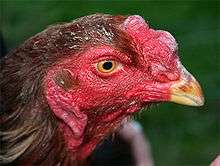
The Aseel, a fighting breed
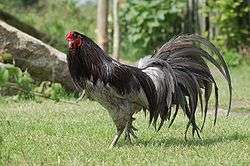
Sumatra cock
|
|
- Kedu (nationally standardized)
- Sentul (nationally standardized)
- Kokok Balenggek (nationally standardized)
- Pelung (long-crower from West Java, locally standardized)
|
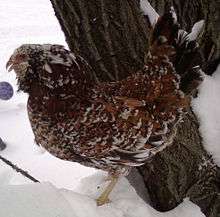
The Orloff, an Iranian breed

Leghorn hen

The Barnevelder
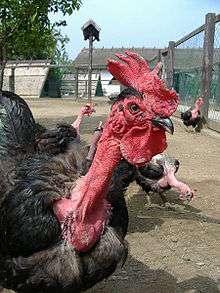
Naked-neck
|
|
- Svrljig Black (Svrljiška kokoš)[4][36]
|

A Minorca rooster
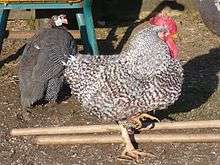
A Cantabrian Pedresa rooster without tail feathers
- Åsbohöna[4]
- Bohuslän-Dals svarthöna[4]
- Gotlandshöna[4]
- Hedemorahöna[4]
- Ölandshöns[4]
|
- Öländsk dvärghöna[4]
- Orusthöna[4]
- Skånsk blommehöna[4]
- Svensk dvärghöna[4]
- Silverudd Blue/Isbar[4]
|
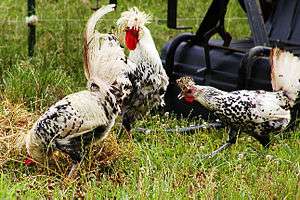
The Appenzeller, a rare Swiss crested breed
.jpg)
The Sultan, a Turkish breed
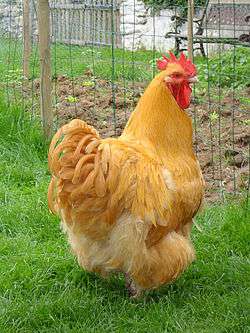
A Buff Orpington cock
By primary use
All chickens lay eggs, have edible meat, and possess a unique appearance. However, distinct breeds are the result of selective breeding to emphasize certain traits. Any breed may technically be used for general agricultural purposes, and all breeds are shown to some degree. But each chicken breed is known for a primary use.
Eggs
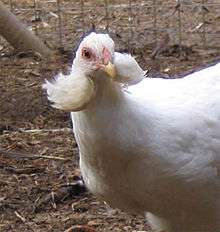
An Araucana
Many breeds were selected and are used primarily for producing eggs, these are mostly light-weight birds whose hens do not go broody often.
Meat
Most farms and homesteads use dual-purpose breeds for meat production. Some breeds are raised mainly for meat:
Dual-purpose

Barred Plymouth Rock, a dual-purpose breed
The generalist breeds used in barnyards worldwide are adaptable utility birds good at producing both meat and eggs. Though some may be slightly better for one of these purposes, they are usually called dual-purpose breeds.
Exhibition
Since the 19th century, poultry fancy, the breeding and competitive exhibition of poultry as a hobby, has grown to be a huge influence on chicken breeds. Many breeds have always been kept for ornamental purposes, and others have been shifted from their original use to become first and foremost exhibition fowl, even if they may retain some inherent utility. Since the sport of cockfighting has been outlawed in the developed world, most breeds first developed for this purpose, called game fowl, are now seen principally in the show ring rather than the cock pit as fighting cocks.
| Key |
|
|
U denotes a breed primarily used for exhibition, but which is still used for utility purposes. |
|
G denotes a game breed. |
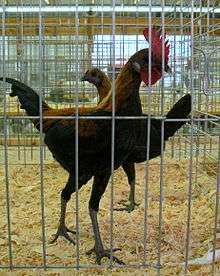
Modern Game Fowl
Bantams

Golden Sebright cockerel
Most large chicken breeds have a bantam counterpart, sometimes referred to as a miniature. Miniatures are usually one-fifth to one-quarter the size of the standard breed, but they are expected to exhibit all of the standard breed's characteristics. A true bantam has no large counterpart, and is naturally small. The true bantams include:
Cross-breeds
See also Category:Chicken hybrids
Many common strains of cross-bred chickens exist, but none breed true or are recognized by poultry breed standards. Thus, though they are extremely common in flocks focusing on high productivity, cross-breeds do not technically meet the definition of a breed. Most cross-breed strains are sex linked, allowing for easy chick sexing.
See also
- 1 2 3 4 (Ekarius 2007, p. 23)
- 1 2 (Ekarius 2007)
- 1 2 (Heinrichs 2007)
- 1 2 3 4 5 6 7 8 9 10 11 12 13 14 15 16 17 18 19 20 21 22 23 24 25 26 27 28 29 30 31 32 33 34 35 36 37 38 39 40 41 42 43 44 45 46 47 48 49 50 51 52 53 54 55 56 57 58 59 60 61 62 63 64 65 66 67 68 69 70 71 72 73 74 75 76 77 78 79 80 81 82 83 84 85 86 87 88 89 90 91 92 93 94 95 96 97 98 99 100 101 102 103 104 105 106 107 108 109 110 111 112 113 114 115 116 117 118 119 120 121 122 123 124 125 126 127 128 129 130 131 132 133 134 135 136 137 138 Domestic Animal Diversity Information System. Food and Agriculture Organization of the United Nations. Accessed January 2012.
- ↑ "Altsteirer". Feathersite.com. Accessed January 2012.
- 1 2 3 4 5 6 7 8 9 10 11 12 13 14 15 16 Grandes volailles (in French) Association pour la Promotion des Animaux de Basse-cour Belges. Accessed January 2012. "Large poultry breeds"
- 1 2 3 4 5 6 7 8 9 10 11 12 13 14 15 16 17 18 19 20 Volailles naines (in French) Association pour la Promotion des Animaux de Basse-cour Belges. Accessed January 2012. "Dwarf poultry breeds"
- ↑ "Croatian Hen". Feathersite.com. Accessed January 2012.
- ↑ http://www.rfp-europe.org/fileadmin/SITE_ERFP/country_reports/Crotia/CR_Croatia_2009.pdf
- ↑ http://www.eaap.org/Previous_Annual_Meetings/2009Barcelona/Papers/01_Gardianova.pdf
- ↑ "Biodiversity in the CR/animals genetic resources". Enrin.grida.no. Accessed January 2012.
- 1 2 "Czech chicken breeds". Accessed January 2012.
- 1 2 3 4 5 6 7 8 9 10 11 12 13 Nikkonen, Terhi (2011) Finnish AnGR conservation programme: What and how? MTT Agrifood Research Finland. Accessed January 2012.
- ↑ "Finnish Chickens". Feathersite.com. Accessed January 2012.
- ↑ "Finnish National Animal Genetic Resources Program / Each country's work / Nordic conservation work / InnehĂĽll / Farm Animals / NordGens webbplats - Nordic Genetic Resource Center". Nordgen.org. Accessed January 2012.
- 1 2 3 4 5 6 7 8 9 10 11 12 13 14 15 16 17 18 19 20 21 22 23 24 25 26 27 28 29 30 31 32 33 34 35 36 37 38 39 40 41 French fowl Fédération française des volailles. Accessed January 2012.
- 1 2 3 4 5 6 7 8 9 10 11 12 13 14 15 16 17 18 19 20 21 22 23 Hühner 2011 (in German) Bund Deutscher Rassegeflügelzüchter e.V. Accessed January 2012. "Chickens 2011"
- 1 2 3 4 5 6 7 8 9 10 11 12 13 14 15 16 17 18 19 20 21 22 23 24 25 26 27 28 29 30 31 32 33 34 35 36 37 38 39 40 41 42 43 44 45 46 47 48 49 50 51 52 53 54 55 56 57 58 59 60 61 62 63 64 65 66 67 68 69 70 71 72 73 74 75 76 77 78 79 80 81 82 83 Listing of European Poultry Breeds and Colours, 2013, entente-ee.com
- 1 2 3 4 5 6 7 8 9 10 11 12 13 14 15 16 17 18 19 20 21 22 23 24 25 26 27 28 29 30 31 32 33 34 35 36 37 38 39 40 41 42 43 44 45 46 47 Zwerghühner 2011 (in German) Bund Deutscher Rassegeflügelzüchter e.V. Accessed January 2012. "Dwarf chickens 2011"
- ↑ "Arca-Net". Arca-net.info. Accessed January 2012.
- ↑ "Arca-Net". Arca-net.info. Accessed January 2012.
- ↑ "Arca-Net". Arca-net.info. Accessed January 2012.
- ↑ "Arca-Net". Arca-net.info. Accessed January 2012.
- ↑ "Arca-Net". Arca-net.info. Accessed January 2012.
- ↑ "Arca-Net". Arca-net.info. Accessed January 2012.
- ↑ "Arca-Net". Arca-net.info. Accessed January 2012.
- ↑
- ↑ (Percy 2006, p. 17)
- 1 2 3 4 5 6 7 8 9 10 11 12 13 14 15 16 17 18 19 20 21 Atlante delle razze * di polli (in Italian) Accessed January 2012. "Atlas of chicken breeds"
- ↑ "Kosova Long Crowing Rooster". Retrieved 18 July 2012.
- 1 2 3 4 5 6 7 8 9 10 11 12 13 14 15 16 17 18 19 20 Hoenders en dwerghoenders (in Dutch) Nederlandse Bond van Hoender, Dwerghoender, Sier- en Watervogelhouders. Accessed January 2012. "Chickens and dwarf chickens".
- 1 2 3 4 5 Breeds reported by Philippines: Chicken. Domestic Animal Diversity Information System of the Food and Agriculture Organization of the United Nations. Accessed June 2014.
- 1 2 3 4 5 Feleciano R. Bejar, Manuel J. Baylon, Jaime B. Fabillar, Lagrito Ebert B. Mante, Arturo A. Ultra, Reynaldo R. Aquino, Elvie T. Bejar (2012). Management Practices and Morphological Characterization of Indigenous (Native) Chickens in Samar Province. Southeast Asian Regional Center for Graduate Study and Research in Agriculture: Agriculture & Development Discussion Paper Series No. 2012-3.
- 1 2 3 4 Aves (in Portuguese) Associação dos Criadores de Bovinos de Raça Barrosã. Accessed January 2012. "Birds"
- ↑ Banatski gološijan standard (in Serbian) Udruzenje za zastitu i odgoj sitnih zivotinja Sremska Mitrovica. Accessed January 2012.
- ↑ Svrljig Kokos Balkan Network for Agrobiodiversity. Accessed January 2012.
- 1 2 3 Agricultural Research Council - The indigenous poultry breeds of SA
- 1 2 3 4 5 6 7 8 9 10 11 12 Ganaderia: Catálogo Oficial de Razas de Ganado de España (in Spanish) Ministerio de Medio Ambiente y Medio Rural y Marino. Accessed January 2012 (click Razas, then Catálogo Oficial de razas). "Breeding: official catalogue of agricultural breeds in Spain".
- ↑ Asociacion Cántabra para la Conservación y Fomento de la Gallina Pedresa.
- 1 2 3 Breeds reported by Thailand: Chicken. Domestic Animal Diversity Information System of the Food and Agriculture Organization of the United Nations. Accessed June 2016.
- ↑ "Pradu Hang Dam Chiangmai". Poultry Research and Development Section, Bureau of Animal Husbandry and Genetic Improvement, Department of Livestock Development, Thailand.
- ↑ Victoria Roberts (2008). British poultry standards: complete specifications and judging points of all standardized breeds and varieties of poultry as compiled by the specialist breed clubs and recognised by the Poultry Club of Great Britain. Oxford: Blackwell. ISBN 9781405156424.
- ↑ "Denizli Rooster". Kultur.Gov.Tr. Department of Culture and Tourism, Republic of Turkey. Retrieved 16 June 2014.
References
- Ekarius, Carol (2007). Storey's Illustrated Guide to Poultry Breeds. 210 MAS MoCA Way, North Adams MA 01247: Storey Publishing. ISBN 978-1-58017-667-5.
- Heinrichs, Christine (2007). How To Raise Chickens. Voyageur Press. ISBN 978-0-7938-0601-0.
- Percy, Pam (2006). The Field Guide to Chickens. Suite 200, 380 Jackson St, St Paul MN 55101: Voyageur Press. ISBN 0-7603-2473-5.






.jpg)











.jpg)




